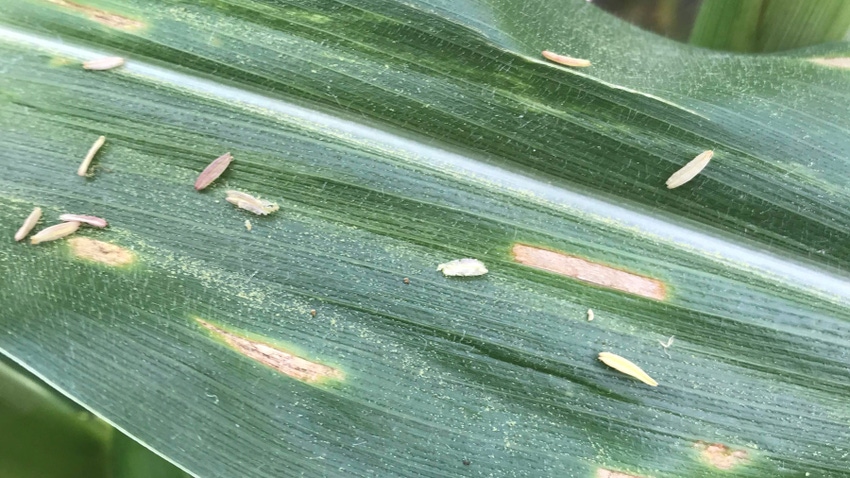June 5, 2023

by Rebecca Vittetoe
It’s getting to be that time of year when we start thinking more about foliar diseases in corn and making foliar fungicide applications. Here are some reminders and considerations to help as you make fungicide decisions this year.
It’s important to scout and know what disease or diseases (if any) are present in your field(s). What we are seeing in the field goes back to the disease triangle. For a disease to be present, we need three things: 1) the pathogen, 2) a susceptible host, and 3) a favorable environment. The big question mark each year is the favorable environment.
With scouting, while we don’t have a specific economic threshold for diseases like we do for many of our insect pests, it’s still important to note how much disease are you seeing and where you are seeing it in the crop canopy. The ear leaf and leaves above are the leaves we really want to protect.
Take time to identify what diseases(s) you are seeing in the field. While most of our foliar corn diseases are caused by a fungus, we do have some diseases — specifically, bacterial leaf streak and Goss’s wilt — that are caused by bacteria.
Determine disease differences
Bacterial leaf streak can easily be confused with gray leaf spot. To distinguish between the two, it’s recommended to hold the leaves up to the sun — and with bacterial leaf streak, you will notice more of a yellow halo or bright yellow streaks extending from the lesions. Additionally, noting where in the canopy you are seeing the disease can be helpful. Gray leaf spot always starts at the bottom of the canopy around VT and works its way up, whereas bacterial leaf streak appears in the top of the canopy at any time, but we usually see it after a period of heavy rain and wind.
Spraying a fungicide on a bacterial disease obviously won’t have any effect on the disease.
Consider the weather outlook. We may have had favorable conditions for a disease to show up, but we may not see the disease progress if the environment changes. For instance, if it turns hot and dry, we are less likely to see diseases continue to develop compared to when we have more moderate temperatures and leaf wetness due to rain, dew, humidity or irrigation. On the other hand, if we continue to have a favorable environment, a disease could really take off and cause a more significant yield impact.
Timing the application
Another big question is around the timing of a fungicide application. The general window we see most foliar fungicides applied is between VT and R2; however, for gray leaf spot it may be more advantageous to spray earlier based on research Iowa State University has done looking at application timings and fungicide products. A V12 fungicide application usually reduces gray leaf spot better than an R1 application. In contrast, with tar spot there was a greater reduction in disease severity with a R1 application.
For a list of fungicides effective against diseases like tar spot, gray leaf spot and northern corn leaf blight, as well as diseases on corn, the publication Fungicide efficacy for control of corn diseases is available from the Crop Protection Network. This publication is updated annually by corn pathologists across the U.S. and in Ontario, Canada.
We don’t talk about fungicide resistance as much as herbicide resistance, but fungicide resistance is real with our fungal pathogens and fungicides we use on our crops. We’ve already documented resistance with the pathogens that causes frogeye leaf spot and septoria brown spot to our quinone outside inhibitor (QoI) or strobilurin fungicides (Fungicide Resistance Action Committee Code 11). To help reduce the risk of fungicide resistance from developing, it is important to use Integrated Pest Management, mix and alternate fungicides (use multiple effective modes of action or FRAC codes) and follow label recommendations.
Vittetoe is an Iowa State University Extension field agronomist.
You May Also Like




